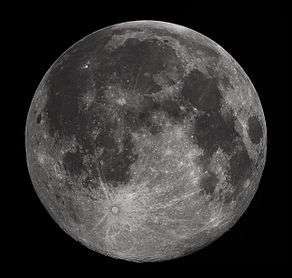Buzz Aldrin
| Buzz Aldrin | |
|---|---|
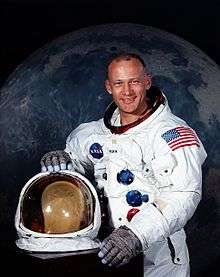 Aldrin in July 1969 | |
NASA Astronaut | |
| Nationality | American |
| Status | Retired |
| Born |
Edwin Eugene Aldrin Jr. January 20, 1930 Mountainside Hospital, Glen Ridge, New Jersey, U.S. |
Other occupation | Fighter pilot |
|
United States Military Academy, B.S. 1951 Massachusetts Institute of Technology, Sc.D. 1963 | |
| Rank |
|
Time in space | 12 days 1 hour and 52 minutes |
| Selection | 1963 NASA Group 3 |
Total EVAs | 4 |
Total EVA time | 7 hours 52 minutes |
| Missions | Gemini 12, Apollo 11 |
Mission insignia |
|
| Retirement | July 1, 1971 |
| Awards |
|
| Website |
www |
| Spouse(s) |
Jean Ann Archer (1954 - 1972) (divorced) Beverly Van Zile (1975 - 1978) (divorced) Lois Driggs Cannon (1988 - 2012) (divorced) |
| Children | 3 |
Buzz Aldrin (born Edwin Eugene Aldrin Jr., January 20, 1930) is an American engineer and former astronaut. As the Lunar Module Pilot on Apollo 11, he was one of the first two humans to land on the Moon, and the second person to walk on it. He set foot on the Moon at 03:15:16 on July 21, 1969 (UTC), following mission commander Neil Armstrong. He is a former U.S. Air Force officer with the Command Pilot rating.
Biography
Early life
Aldrin was born January 20, 1930, in Mountainside Hospital, in Glen Ridge, New Jersey.[1][2] His parents were Edwin Eugene Aldrin Sr. (1896–1974), a career military man, and Marion (Moon) Gaddys (1903–1968), who lived in neighboring Montclair.[3][4] He is of Scottish, Swedish,[5] and German ancestry. Aldrin was a Boy Scout and earned the rank of Tenderfoot Scout.[6]
After graduating from Montclair High School in 1947,[1][7] Aldrin turned down a full scholarship offer from the Massachusetts Institute of Technology (which he would later attend for graduate school), and went to the United States Military Academy at West Point, New York. The nickname "Buzz" originated in childhood: the younger of his two elder sisters mispronounced "brother" as "buzzer", and this was shortened to Buzz. Aldrin made it his legal first name in 1988.[8]
Military career
Aldrin graduated third in his class at West Point in 1951 with a Bachelor of Science degree in mechanical engineering. He was commissioned as a Second Lieutenant in the United States Air Force and served as a jet fighter pilot during the Korean War. He flew 66 combat missions in F-86 Sabres and shot down two Mikoyan-Gurevich MiG-15 aircraft. The June 8, 1953, issue of Life magazine featured gun camera photos taken by Aldrin of one of the Soviet pilots ejecting from his damaged aircraft.[9]
After the war, Aldrin was assigned as an aerial gunnery instructor at Nellis Air Force Base in Nevada, and next was an aide to the dean of faculty at the United States Air Force Academy, which had recently begun operations in 1955. That same year, he graduated from the Squadron Officer School at Maxwell Air Force Base in Alabama. He flew F-100 Super Sabres as a flight commander at Bitburg Air Base, West Germany, in the 22d Fighter Squadron.
In January 1963, Aldrin earned a Sc.D. degree in astronautics from the Massachusetts Institute of Technology, where he had been assigned as a graduate student (under the auspices of the Air Force Institute of Technology) since 1959.[10][11] His doctoral thesis was Line-of-Sight Guidance Techniques for Manned Orbital Rendezvous, the dedication of which read, "In the hopes that this work may in some way contribute to their exploration of space, this is dedicated to the crew members of this country’s present and future manned space programs. If only I could join them in their exciting endeavors!"[12]
On completion of his doctorate, he was assigned to the Gemini Target Office of the Air Force Space Systems Division in Los Angeles before his selection as an astronaut. His initial application to join the astronaut corps was rejected on the basis of never having been a test pilot; that prerequisite was lifted when he re-applied and was accepted into the third astronaut class.[13]
NASA career
Gemini program

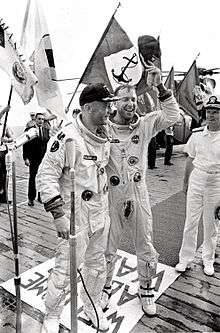
Aldrin was selected as a member of the third group of NASA astronauts in October 1963. Because test pilot experience was no longer a requirement, this was the first selection for which he was eligible. After the deaths of the original Gemini 9 prime crew, Elliot See and Charles Bassett, Aldrin and Jim Lovell were promoted to backup crew for the mission. The main objective of the revised mission (Gemini 9A) was to rendezvous and dock with a target vehicle, but when this failed, Aldrin improvised an effective exercise for the craft to rendezvous with a co-ordinate in space. He was confirmed as pilot on Gemini 12, the last Gemini mission and the last chance to prove methods for extravehicular activity (EVA). He set a record for EVA, demonstrating that astronauts could work outside spacecraft.[14]
Apollo program
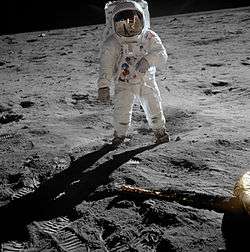
Magnificent desolation.
Aldrin's first impression of the Moon, standing on its surface.[15]
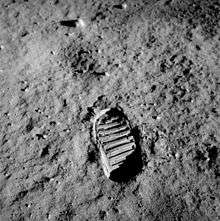
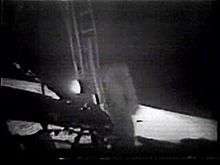
Aldrin was chosen for the crew of Apollo 11 and made the first lunar landing with commander Neil Armstrong on July 20, 1969. The next day, Aldrin became the second person to walk on the Moon, keeping his record total EVA time until that was surpassed on Apollo 14. Aldrin's first words on the Moon were "Beautiful view." Then, in response to Armstrong asking, "Isn't it magnificent?", he responded, "Magnificent desolation."[16] He was also the first person to urinate while on the Moon.[17][18][19]
There has been speculation about the extent of Aldrin's desire at the time to be the first astronaut to walk on the Moon and its impact on his pre-flight, in-mission and post-flight actions.[20] According to different NASA accounts, the Lunar Module Pilot (i.e. Aldrin on Apollo 11) had originally been proposed as the first to step onto the Moon's surface in early versions of the EVA checklist, and when Aldrin became aware that this might be amended, he lobbied within NASA for the original procedure to be followed. A number of factors seem to have contributed to the final decision, including the physical positioning of the astronauts inside the compact lunar lander, which made it easier for Armstrong to be the first to exit the spacecraft. Also, Armstrong was the Mission Commander, and other senior astronauts who would command later Apollo missions (and who might have ended up making the first landing in the event of failure on Apollo 11) were not sympathetic to Aldrin's views.[21] Apollo 11 Command Module Pilot Michael Collins commented that he thought Aldrin "resents not being first on the moon more than he appreciates being second."[22]
Aldrin, a Presbyterian, was the first person to hold a religious ceremony on the Moon. After landing on the Moon, he radioed Earth: "I'd like to take this opportunity to ask every person listening in, whoever and wherever they may be, to pause for a moment and contemplate the events of the past few hours, and to give thanks in his or her own way." He took communion on the surface of the Moon, but he kept it secret because of a lawsuit brought by atheist activist Madalyn Murray O'Hair over the reading of Genesis on Apollo 8.[23] Aldrin, then a church elder, used a home communion kit given to him, and recited words used by his pastor at Webster Presbyterian Church, the Rev. Dean Woodruff.[24][25] The communion elements were the first food and liquid consumed on the Moon: in Guideposts, Aldrin stated: "It was interesting to think that the very first liquid ever poured on the Moon, and the first food eaten there, were communion elements."[26]
Later Aldrin commented on the event: "Perhaps, if I had it to do over again, I would not choose to celebrate communion. Although it was a deeply meaningful experience for me, it was a Christian sacrament, and we had come to the Moon in the name of all mankind – be they Christians, Jews, Muslims, animists, agnostics, or atheists. But at the time I could think of no better way to acknowledge the enormity of the Apollo 11 experience than by giving thanks to God."[26][27] Mindful of the controversy caused by the Bible readings made by the Apollo 8 crew, the NASA management had warned the Apollo 11 crew against making any explicit religious comments during the flight. However, in the final Apollo 11 TV broadcast during the return journey to Earth, Aldrin quoted from Psalm 8 (verses 3 and 4)[28] "I’ve been reflecting the events of the past several days and a verse from the Psalms comes to mind to me. 'When I consider the heavens, the work of thy fingers, the moon and the stars which thou hast ordained, what is man that thou art mindful of him?'".[29][30] This particular quote seems to have been accepted as a personal observation and did not precipitate any controversy.
Retirement
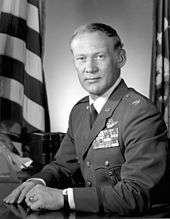
After leaving NASA in July 1971, Aldrin was assigned as the Commandant of the U.S. Air Force Test Pilot School at Edwards Air Force Base, California. In March 1972, Aldrin retired from active duty after 21 years of service, and returned to the Air Force in a managerial role, but his career was blighted by personal problems. His autobiographies Return to Earth, published in 1973, and Magnificent Desolation, published in June 2009, both provide accounts of his struggles with clinical depression and alcoholism in the years following his NASA career.[31] Aldrin's life improved considerably when he recognized and sought treatment for his problems.
Since retiring from NASA, he has continued to promote space exploration. In 1985 he joined the University of North Dakota's College of Aerospace Sciences (now the John D. Odegard School of Aerospace Sciences) at the invitation of John D. Odegard, the dean of the college at time. Aldrin helped to develop UND's Space Studies program and brought Dr. David Webb from NASA to serve as the department's first chair.[32] Later, he produced a computer strategy game called Buzz Aldrin's Race Into Space (1993). To further promote space exploration, and to commemorate the 40th anniversary of the first lunar landing, Aldrin teamed up with Snoop Dogg, Quincy Jones, Talib Kweli, and Soulja Boy to create the rap single and video, "Rocket Experience", with proceeds from video and song sales to benefit Aldrin's non-profit foundation, ShareSpace.[33]
He referred to the Phobos monolith in a July 22, 2009, interview with C-SPAN: "We should go boldly where man has not gone before. Fly by the comets, visit asteroids, visit the moon of Mars. There's a monolith there. A very unusual structure on this potato shaped object that goes around Mars once in seven hours. When people find out about that they're going to say 'Who put that there? Who put that there?' The universe put it there. If you choose, God put it there…"[34]
Aldrin has voiced parody versions of himself in two of Matt Groening's animated series: The Simpsons episode "Deep Space Homer", in which he accompanies Homer Simpson on a trip into space as part of NASA's plan to improve its public appearance, and the Futurama episode "Cold Warriors". In 2011, Aldrin appeared as himself in the film Transformers: Dark of the Moon, where he explains to Optimus Prime and the Autobots that the Apollo 11 mission also discovered a Cybertronian ship on the Moon whose existence was concealed from the public.
In 2012, he made a cameo appearance in Japanese drama film Space Brothers.[35] Aldrin appeared as himself in the Big Bang Theory episode, "The Holographic Excitation", which aired on October 25, 2012.[36] Aldrin also lent his voice talents to the 2012 video game Mass Effect 3, playing a stargazer who appears in the game's final scene.[37]
In December 2016, Aldrin was visiting the Amundsen–Scott South Pole Station, Antarctica as part of a tourist group, when he fell ill and was evacuated, first to McMurdo Station and from there to Christchurch, New Zealand, where he was reported to be in stable condition.[38]
Aldrin cycler
In 1985, Aldrin proposed the existence of a special spacecraft trajectory now known as the Aldrin cycler.[39][40] Aldrin's system of cycling spacecraft makes travel to Mars possible using far less propellant than conventional means, with an expected five and a half month journey from the Earth to Mars, and a return trip to Earth of about the same duration on a twin-cycler. Aldrin is still working on this with engineers from Purdue University.[41]
Bart Sibrel incident
On September 9, 2002, Aldrin was lured to a Beverly Hills hotel on the pretext of being interviewed for a Japanese children's television show on the subject of space. When he arrived, Apollo conspiracy proponent Bart Sibrel accosted him with a film crew and demanded he swear on a Bible that the Moon landings were not faked, insisting that Aldrin and others had lied about walking on the Moon. After a brief confrontation, in which Sibrel called him "a coward and a liar",[42] Aldrin punched Sibrel in the jaw, which was caught on camera by Sibrel's film crew. The police determined that Aldrin was provoked and no charges were filed.[43] Aldrin dedicates a chapter to this incident in his autobiography Magnificent Desolation.[44]
Views
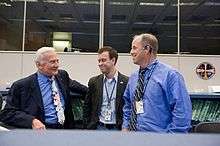
Criticism of NASA's 2003 return-to-Moon objectives
In December 2003, Aldrin published an opinion piece in The New York Times criticizing NASA's objectives.[45] In it, he voiced concern about NASA's development of a spacecraft "limited to transporting four astronauts at a time with little or no cargo carrying capability" and declared the goal of sending astronauts back to the Moon was "more like reaching for past glory than striving for new triumphs".[45]
Support of a manned mission to Mars
In June 2013, Aldrin wrote an opinion, published in The New York Times, supporting a manned mission to Mars and which viewed the Moon "not as a destination but more a point of departure, one that places humankind on a trajectory to homestead Mars and become a two-planet species."[46] In August 2015, Aldrin, in association with the Florida Institute of Technology, presented a "master plan", for NASA consideration, for astronauts, with a "tour of duty of ten years", to colonize Mars before the year 2040.[47]
Climate change
In 2009, Aldrin commented on climate change by saying: "I think the climate has been changing for billions of years. If it's warming now, it may cool off later. I'm not in favor of just taking short-term isolated situations and depleting our resources to keep our climate just the way it is today. I'm not necessarily of the school that we are causing it all, I think the world is causing it."[48]
Books
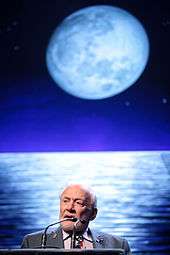
Books co-authored by Aldrin include Return to Earth (1973), Men From Earth (1989), Reaching for the Moon (2005), Look to the Stars (2009) and Magnificent Desolation (2009). He has also co-authored with John Barnes the science fiction novels Encounter with Tiber (1996) and The Return (2000). His book Mission to Mars was published in May 2013. In April 2016, he released his latest book, No Dream is Too High.
Awards and honors
 | ||
- Civilian awards and decorations include the Robert J. Collier Trophy, the Dr. Robert H. Goddard Memorial Trophy, and the Harmon Trophy.
- Aldrin and his Apollo 11 crewmates were the 1999 recipients of the Langley Gold Medal from the Smithsonian Institution.
- The crater Aldrin on the Moon near the Apollo 11 landing site and Asteroid 6470 Aldrin are named in his honor.
- In 1967, Aldrin received an Honorary Doctorate of Science from Gustavus Adolphus College.
- In 1985, Aldrin was inducted into the Scandinavian-American Hall of Fame, a signature event of Norsk Høstfest.[49]
- In 1994, Aldrin was anonymously honored on a United States postage stamp. The 29¢ stamp, commemorating the silver anniversary of the landing, was based on a famous photograph of Aldrin, captured by Neil Armstrong, in which Aldrin's face is obscured by his reflective visor. Postal rules at the time prohibited directly featuring living persons on stamps.[50]
- In 2001, President Bush appointed Aldrin to the Commission on the Future of the United States Aerospace Industry.[51]
- Aldrin received the 2003 Humanitarian Award from Variety, the Children's Charity, which, according to the organization, "is given to an individual who has shown unusual understanding, empathy, and devotion to mankind."[52]
- Aldrin is on the National Space Society's Board of Governors, and has served as the organization's Chairman; an inductee of the U.S. Astronaut Hall of Fame, National Aviation Hall of Fame and the International Space Hall of Fame; and a member of The Planetary Society, with Aldrin's pre-recorded voice appearing on nearly every episode of the Society's Planetary Radio.
- In 2006, the Space Foundation awarded Aldrin its highest honor, the General James E. Hill Lifetime Space Achievement Award.[53]
- For contributions to the television industry, Aldrin was honored with a star on the Hollywood Walk of Fame.[54]
- Inducted into the New Jersey Hall of Fame in 2008.[55]
- In 2009, President Obama signed legislation conferring the Congressional Gold Medal upon Aldrin and his Apollo 11 crewmates, Neil Armstrong and Michael Collins.
- In a 2010 Space Foundation survey, Aldrin was ranked as the No. 9 (tied with astronauts Gus Grissom and Alan Shepard) most popular space hero.[56]
- In 2011, Aldrin was nominated for Best Cameo at the 2011 Scream Awards for his role playing himself in Transformers: Dark of the Moon.
- In 2015, Aldrin was named as the Chancellor of the International Space University.[57]
- In 2016 Aldrin's hometown middle school in Montclair New Jersey will be renamed the Buzz Aldrin Middle School.[58]
Detached adapter panel sighting

In 2005, while being interviewed for a documentary titled First on the Moon: The Untold Story, Aldrin told an interviewer that they saw an unidentified flying object. Aldrin told David Morrison, a NASA Astrobiology Institute senior scientist, that the documentary cut the crew's conclusion that they were probably seeing one of four detached spacecraft adapter panels. Their S-IVB upper stage was 6,000 miles (9,700 km) away, but the four panels were jettisoned before the S-IVB made its separation maneuver so they would closely follow the Apollo 11 spacecraft until its first midcourse correction.[59] When Aldrin appeared on The Howard Stern Show on August 15, 2007, Stern asked him about the supposed UFO sighting. Aldrin confirmed that there was no such sighting of anything deemed extraterrestrial, and said they were and are "99.9 percent" sure that the object was the detached panel.[60][61]
Interviewed by the Science Channel, Aldrin mentioned seeing unidentified objects, and according to Aldrin his words were taken out of context; he asked the Science Channel to clarify to viewers he did not see alien spacecraft, but they refused.[62]
Personal life
Aldrin has been married three times. His first marriage was to Joan Archer (1954–1974), the mother of his three children (James, Janice and Andrew). His second marriage was to Beverly Zile (1975–1978). His third marriage was to Lois Driggs Cannon (1988–2011), from whom he filed for divorce on June 15, 2011, in Los Angeles, citing "irreconcilable differences".[63] The divorce was finalized on December 28, 2012.[64] He has one grandson, Jeffrey Schuss, born to his daughter, Janice.
His battles against depression and alcoholism, upon returning home from the Apollo 11 mission, have been documented, most recently in Magnificent Desolation.[65][66] Aldrin is an active supporter of the Republican Party, headlining fundraisers for GOP members of Congress.[67]
In 2007, Aldrin confirmed to Time magazine that he had recently had a face-lift;[68] he joked that the G-forces he was exposed to in space "caused a sagging jowl that needed some attention."[68]
Aldrin commented on the death of his Apollo 11 colleague, Neil Armstrong, saying that he was "deeply saddened by the passing. I know I am joined by millions of others in mourning the passing of a true American hero and the best pilot I ever knew. I had truly hoped that on July 20th, 2019, Neil, Mike and I would be standing together to commemorate the 50th Anniversary of our Moon landing...Regrettably, this is not to be."[69][70]
In 2016, he resided in Satellite Beach, Florida.[71]
Film and television
Filmography
| Year | Title | Role | Notes |
|---|---|---|---|
| 1976 | The Boy in the Plastic Bubble | Himself | TV movie |
| 1989 | After Dark | Himself | Extended appearance on British discussion program, with among others Heinz Wolff, Jocelyn Bell Burnell and Whitley Strieber |
| 1994 | The Simpsons | Himself (voice) | Episode: "Deep Space Homer" |
| 1997 | Space Ghost Coast to Coast | Himself | 2 episodes |
| 1999 | Disney's Recess | Himself (voice) | Episode: "Space Cadet" |
| 2003 | Da Ali G Show | Himself | 2 episodes |
| 2006 | Numb3rs | Himself | Episode: "Killer Chat" |
| 2007 | In the Shadow of the Moon | Himself | Documentary |
| 2008 | Fly Me to the Moon | Himself | |
| 2010 | 30 Rock | Himself | Episode: "The Moms" |
| 2010 | Dancing with the Stars | Himself/contestant | 2nd eliminated in season 10 |
| 2011 | Transformers: Dark of the Moon | Himself | |
| 2011 | Futurama | Himself (voice) | Episode: "Cold Warriors" |
| 2012 | Space Brothers | Himself | |
| 2012 | The Big Bang Theory | Himself | Episode: "The Holographic Excitation" |
| 2012 | Mass Effect 3 | The Stargazer (voice) | Video game |
| 2015 | Jorden runt på 6 steg | Himself | Successfully tested six degrees of separation |
| 2016 | The Late Show with Stephen Colbert | Himself | Was interviewed and took part in a skit |
| 2016 | Hell's Kitchen | Himself | Dining room guest and had his dinner cooked by the blue team due to their team challenge win |
Portrayed by others
Aldrin has been portrayed by:
- Cliff Robertson in Return to Earth (1976)
- Larry Williams in Apollo 13 (1995)
- Xander Berkeley in Apollo 11 (1996)
- Bryan Cranston in From the Earth to the Moon (1998) and Magnificent Desolation: Walking on the Moon 3D (2005)
- James Marsters in Moonshot (2009)
- Cory Tucker as a younger Buzz Aldrin of 1969 in Transformers: Dark of the Moon (2011)
- The name of the Toy Story character Buzz Lightyear was inspired by Buzz Aldrin. Aldrin acknowledged the tribute when he pulled a Buzz Lightyear doll out during a speech at NASA, to rapturous cheer, a clip of which can be found on the Toy Story 10th Anniversary DVD.[72]
Bibliography
- Aldrin, Col. Edwin E. Jr. 1970. Footsteps on the Moon. Edison Electric Institute Bulletin. Vol. 38, No. 7, pp. 266–272.
- Aldrin, Buzz and Wayne Warga. 1973. Return to Earth. New York, Random House.
- Aldrin, Buzz and Malcolm McConnell. 1989. Men from Earth. New York: Bantam Books.
- Aldrin, Buzz and John Barnes. 1996. Encounter with Tiber. London: Hodder & Stoughton, 1996.
- Aldrin, Buzz and John Barnes. 2000. The Return. New York: Forge.
- Aldrin, Buzz and Wendell Minor. 2005. Reaching for the Moon. New York: Harper Collins Publishers.
- Aldrin, Buzz and Ken Abraham. 2009. Magnificent Desolation: The Long Journey Home from the Moon. New York: Harmony Books.
- Aldrin, Buzz and Wendell Minor. 2009. Look to the Stars. Camberwell, Vic.: Puffin Books.
- Armstrong, Neil; Michael Collins; Edwin E. Aldrin; Gene Farmer; and Dora Jane Hamblin. 1970. First on the Moon: A Voyage with Neil Armstrong, Michael Collins, Edwin E. Aldrin Jr. Boston: Little, Brown.
- Aldrin, Buzz. 2013. Mission to Mars. Washington, D.C.: The National Geographic Society.
- Aldrin, Buzz and Marianne Dyson. 2015. Welcome to Mars: Making a Home on the Red Planet. Washington, D.C.: National Geographic Children's Books.
See also
Notes and references
- 1 2 "To the Moon and beyond", The Record (Bergen County), July 20, 2009; retrieved July 20, 2009. The source is indicative of the confusion regarding his birthplace. He is described in the article's first paragraph as having been "born and raised in Montclair, New Jersey", while a more detailed second paragraph on "The Early Years" states that he was "born Edwin Eugene Aldrin Jr. on January 20, 1930, in the Glen Ridge wing of Montclair Hospital".
- ↑ Hansen, James R. (2005). First Man: The Life of Neil A. Armstrong. Simon & Schuster. p. 348. ISBN 0743257510. "His birth certificate lists Glen Ridge as his birthplace."
- ↑ "Archived copy". Archived from the original on 2008-04-02. Retrieved 2008-05-09.; retrieved November 8, 2012.
- ↑ Solomon, Deborah; Oth, Christian (June 21, 2009). "Questions for Buzz Aldrin: The Man on the Moon". The New York Times. Retrieved March 15, 2015.
- ↑ Powell, Sarah."From The Dollar To The Moon. Chapter 7 – That "giant leap for mankind"". Archived from the original on 2010-12-24. Retrieved 2012-11-08. . burkespeerage.com; accessed October 25, 2015.
- ↑ "Scouting and Space Exploration". scouting.org. Archived from the original on 2016-03-04.
- ↑ "Aldrin Was A Classmate" (PDF). Adirondack Daily Enterprise. July 14, 1969. Archived from the original (PDF) on September 27, 2013. Retrieved July 17, 2012.
- ↑ Chaikin, Andrew (2007). A Man on the Moon. Penguin. p. 585. ISBN 014311235X.
- ↑ "Communist Pilot is Catapulted from Crippled MIG". Life. June 8, 1953. p. 29. ISSN 0024-3019. Retrieved November 8, 2012.
- ↑ "Astronaut Bio: Buzz Aldrin". nasa.gov.
- ↑ DSpace@MIT : Line-of-sight guidance techniques for manned orbital rendezvous. Dspace.mit.edu; retrieved November 8, 2012.
- ↑ DSpace@MIT : Line-of-sight guidance techniques for manned orbital rendezvous. Dspace.mit.edu; retrieved November 8, 2012.
- ↑ "Legendary Astronaut, Rocket Scientist and more... | QGITS". QGITS. 2013-05-12. Retrieved 2016-12-01.
- ↑ MSFC, Heather Deiss : (2015-05-12). "What Is a Spacewalk?". NASA. Retrieved 2016-12-01.
- ↑ "International Space Hall of Fame: New Mexico Museum of Space History: Inductee Profile". nmspacemuseum.org.
- ↑ Teague, Kipp, ed. (July 21, 1969). Apollo 11 – Buzz Aldrin Descends Ladder to Lunar Surface (MPEG-1). National Aeronautics and Space Administration. Retrieved December 22, 2013. Lay summary – Apollo 11 Video Library (September 6, 2011).
Beautiful view. Magnificent desolation.
- ↑ Diaz, Jesus (July 20, 2011). "Buzz Aldrin Was the First Man to Pee on the Moon – 42 Years Ago Today". Gizmodo. Retrieved September 23, 2015.
- ↑ Minard, Anne (July 16, 2009). "Buzz Aldrin, First Man (to Pee) on the Moon, Sounds Off". National Geographic News. Retrieved September 23, 2015.
- ↑ Graham, Jane (September 3, 2013). "Letter to my younger self – Buzz Aldrin". Big Issue. Retrieved April 8, 2016.
- ↑ Cortright, Edgar M. (ed.), "8", Apollo Expeditions to the Moon, NASA, p. 7
- ↑ Chaikin, A. (2007). A Man on the Moon. Penguin Books. ISBN 014311235X
- ↑ Collins, Michael (2001). Carrying the Fire; an Astronaut’s Journeys. Cooper Square Press. ISBN 081541028X
- ↑ Chaikin, Andrew, A Man on the Moon, p. 204
- ↑ Armstrong, Neil; Collins, Michael; Aldrin, Buzz; Farmer, Gene; Hamblin, Dora Jane (1970), First on the Moon – A Voyage with Neil Armstrong, Michael Collins, Edwin E. Aldrin Jr., London, UK: Michael Joseph, p. 251, ISBN 0-31605160-8
- ↑ Hillner, Jennifer (January 24, 2007). "Sundance 2007: Buzz Aldrin Speaks". Table of Malcontents – Wired Blogs. Retrieved May 7, 2007.
- 1 2 Cresswell, Matthew (September 13, 2012). "How Buzz Aldrin's communion on the moon was hushed up". The Guardian.
- ↑ Aldrin, Buzz & Ken Abraham (2009). Magnificent Desolation: The Long Journey Home from the Moon. Random House LLC. p. 27; ISBN 9780307463470
- ↑ Ryan, P. (1969) The Invasion of the Moon 1969: The Story of Apollo 11. Penguin Books. Middlesex, England.
- ↑ "4th Day Alliance – Creationism, Creation Science, and Creation Astronomy – Apollo Space Program Bible Quotations". 4thdayalliance.com.
- ↑ "Aldrin note up for auction". usatoday.com.
- ↑ Aldrin, Buzz (2009). Magnificent Desolation: The Long Journey Home from the Moon. Harmony.
- ↑ Rice, Daniel R (1992). The Clifford Years: The University of North Dakota, 1971-1992. p. 46.
- ↑ "Buzz Aldrin and Snoop Dogg reach for the stars with Rocket Experience", The Times, June 25, 2009.
- ↑ "Buzz Aldrin Reveals Existence of Monolith on Mars Moon". C-SPAN. July 22, 2009.
- ↑ "小栗旬&岡田将生主演『宇宙兄弟』に野口聡一、バズ・オルドリンが出演" [Shunichi Noguchi and Buzz Aldrin appear in 'Space Brothers', starring Oguri Shun & Masao Okada]. ぴあ映画生活 (Pia Movie Life) (in Japanese). March 22, 2012. Retrieved December 1, 2016.
- ↑ Goldberg, Lesley (October 9, 2012). "Buzz Aldrin Lands 'Big Bang Theory' Cameo". Hollywood Reporter. Retrieved December 2, 2016.
- ↑ Egan, James. 3000 Facts about Video Games. Lulu.com. p. 159. ISBN 9781326818869.
- ↑ McCann, Erin (December 1, 2016). "Buzz Aldrin Is Evacuated From the South Pole After Falling Ill". New York Times. Retrieved December 1, 2016.
- ↑ Aldrin, E. E., "Cyclic Trajectory Concepts," SAIC presentation to the Interplanetary Rapid Transit Study Meeting, Jet Propulsion Laboratory, October 1985.
- ↑ Byrnes, D. V.; Longuski, J. M.; and Aldrin, B. (1993). "Cycler Orbit Between Earth and Mars" (PDF). Journal of Spacecraft and Rockets. 30 (3): 334–36. doi:10.2514/3.25519. Retrieved October 25, 2015.
- ↑ "Aldrin Mars Cycler". buzzaldrin.com.
- ↑ "ABC U.S. News Videos & Video Clips Online". ABC News.
- ↑ "Ex-astronaut escapes assault charge". BBC News. September 21, 2002. Retrieved July 7, 2012.
- ↑ Aldrin, Buzz (2009). "A Blow Heard 'Round the World". Magnificent Desolation. Harmony Books. p. 281.
- 1 2 Aldrin, Buzz (December 5, 2003). "Fly Me To L1". The New York Times. Retrieved November 14, 2009.
- ↑ Aldrin, Buzz (June 13, 2013). "The Call of Mars". New York Times. Retrieved June 17, 2013.
- ↑ Dunn, Marcia (August 27, 2015). "Buzz Aldrin joins university, forming 'master plan' for Mars". AP News. Retrieved August 30, 2015.
- ↑ Aldrin, Buzz (July 3, 2009). "Buzz Aldrin calls for manned flight to Mars to overcome global problems". The Daily Telegraph. Retrieved January 7, 2011.
- ↑ "Scandinavian-American Hall of Fame:Buzz Aldrin". Hostfest.com. Retrieved March 2, 2014.
- ↑ "'First Moon Landing, 1969' United States postage stamp". Retrieved March 2, 2014.
- ↑ Personnel Announcements – August 22, 2001 White House Press Release naming the Presidential Appointees for the commission.
- ↑ "Variety International Humanitarian Awards". Variety, the Children's Charity. Retrieved May 7, 2007.
- ↑ "Symposium Awards". Archived from the original on 2009-02-03. Retrieved 2012-01-31.; nationalspacesymposium.org
- ↑ Yune, Tommy (July 20, 2009). "Apollo 11 honored on the Hollywood Walk of Fame". CNN. Retrieved July 28, 2016.
- ↑ Frank, Bruce and Buzz among first inducted into NJ hall of fame, The Star-Ledger, October 25, 2007. Retrieved May 3, 2010.
- ↑ "Space Foundation Survey Reveals Broad Range of Space Heroes". spacefoundation.org. October 27, 2010.
- ↑ Buzz Aldrin [TheRealBuzz] (October 14, 2015). "I am so honored to be the new Chancellor of ISU at the #IAC2015 following in Arthur C Clarke's footsteps." (Tweet) – via Twitter.
- ↑ http://www.montclair.k12.nj.us/Article.aspx?Id=1219
- ↑ "Apollo 11 Mission Op Report" (PDF). NASA.
- ↑ Morrison, David (July 26, 2006). "NASA Ask an Astrobiologist". NASA. Archived from the original on July 21, 2011.
- ↑ "Astronaut Buzz Aldrin Recounts Apollo 11 UFO Encounter". ufoevidence.org. July 18, 1969. Retrieved October 25, 2015.
- ↑ Morrison, David (2009). "UFOs and Aliens in Space". Skeptical Inquirer. 33 (1): 30–31. Retrieved October 25, 2015.
- ↑ Roberts, Roxanne and Argetsinger (June 16, 2011). "Love, etc.: Buzz Aldrin divorces; Hugh Hefner gets revenge on ex". The Washington Post.
- ↑ "Buzz Aldrin – Officially Divorced". Ghanamma. Retrieved January 7, 2013.
- ↑ "After walking on moon, astronauts trod various paths". CNN. July 17, 2009. Retrieved April 27, 2010.
- ↑ Read, Kimberly (January 4, 2005). "Buzz Aldrin". Bipolar. About. Retrieved November 2, 2008.
- ↑ Invite (PDF), Combat Veterans For Congress
- 1 2 "10 Questions for Buzz Aldrin". Time.com. September 6, 2007. Retrieved March 2, 2014.
- ↑ Aldrin, Buzz (August 25, 2012). "About passing of Neil Armstrong". The real Buzz. Twitter. Retrieved August 25, 2012.
- ↑ Aldrin, Buzz (August 25, 2012). "On the Passing of Neil Armstrong" (Official statement). Retrieved October 25, 2015.
- ↑ Staff Reports, Wire and (December 2, 2016). "'Ailing' Buzz Aldrin recuperating". Florida Today. Melbourne, Florida. pp. 1A. Retrieved December 2, 2016.
- ↑ "Toy Story 3 Featurette – Buzz Lightyear". Trailer Addict. June 18, 2010. Retrieved 2010-08-29.
External links
| Wikimedia Commons has media related to Buzz Aldrin. |
| Wikiquote has quotations related to: Buzz Aldrin |
- Official website
- Aldrin's official NASA biography
- Astronautix biography of Buzz Aldrin
- Spacefacts biography of Buzz Aldrin
- Iven C. Kincheloe Awards
- A February 2009 BBC News item about Buzz Aldrin's Moon memories, looking forward to the 40th anniversary of the first Moon landing
- "Satellite of solitude" by Buzz Aldrin: an article in which Aldrin describes what it was like to walk on the Moon, Cosmos science magazine
- To the Moon... with Buzz Aldrin
- Aldrin at Spaceacts
- Aldrin at Encyclopedia of Science
- Buzz Aldrin at the Internet Movie Database
- Buzz Aldrin at the National Aviation Hall of Fame
- Video interview with Buzz Aldrin Buzz is shown an enlarged print of Tranquility Base and talks Graeme Hill through the points of significance.
- Video interview on AstrotalkUK
- Aldrin at International Space Hall of Fame
- Buzz Aldrin's Quotes
- Buzz Aldrin Paul Mauriat's History
- Appearances on C-SPAN
